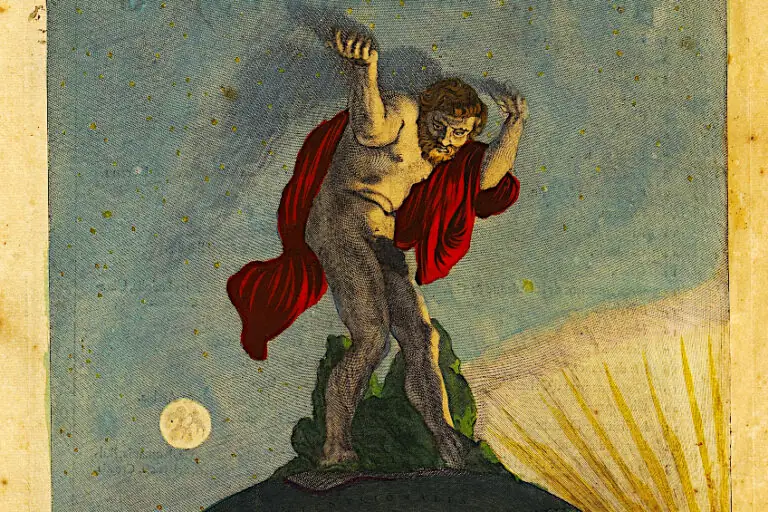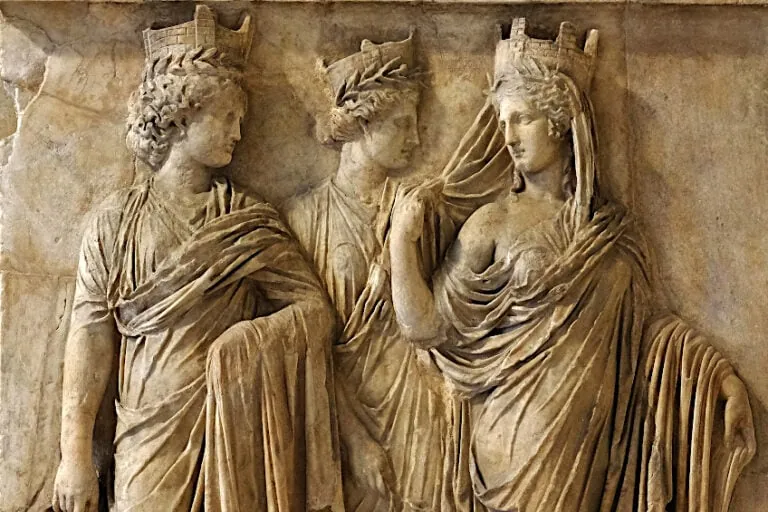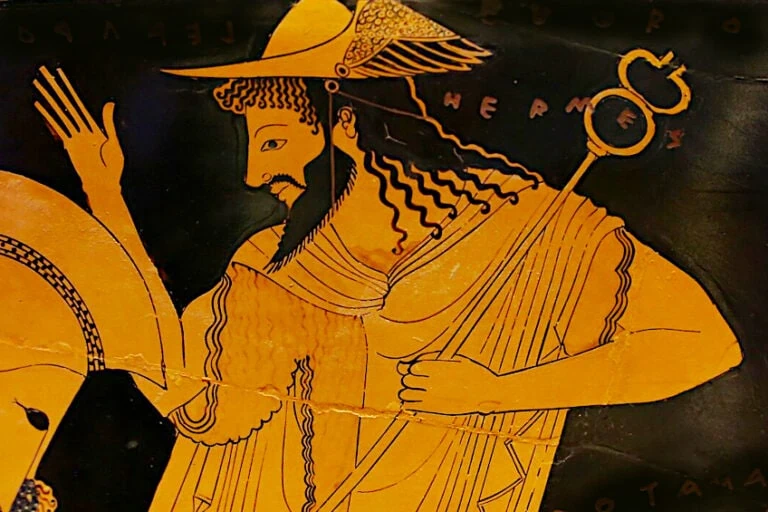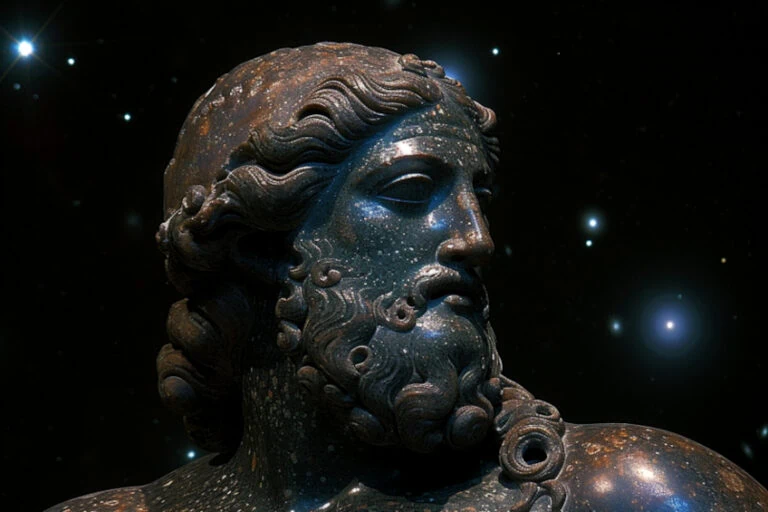Greek Goddess Styx – Dread Guarantor of Divine Oaths
The Greek goddess Styx is an intriguing figure in Greek mythology, and is perhaps one of the most famous rivers in the ancient Greek world, aside from her father, Oceanus, who encircled the world. This underworld river goddess was responsible for the ironclad oaths the gods swore upon her waters, and featured in many writings in this capacity. Styx is also the river responsible for Achilles’ famed invincibility. Come with us as we take a trip exploring this powerful and spooky goddess below!
Contents
The Goddess of the Dread River
| Name | Styx |
| Gender | Female |
| God of | Oaths and an underworld river |
| Personality | Gloomy, forbidding, and wrathful |
| Symbols | The river Styx |
| Consorts | Pallas |
| Children | Kratos, Bia, Zelus, and Nike |
| Parents | Oceanus and Tethys |
The Greek goddess Styx in mythology was a unique character that never appeared in person in myth but played a key role throughout it. A powerful goddess known as the “dread river of oaths”, was the one upon whose waters the gods would swear the most powerful and ironclad oaths.
In this way, alliances and truces were struck, and truths were verified or made manifest by force across Greek myth and literature. Oaths sworn on Styx were most feared by the deathless gods, and in this way, she held a powerful influence in the world.
 Zeus swearing an oath by pouring a libation to Styx; artist’s impression
Zeus swearing an oath by pouring a libation to Styx; artist’s impression
Background of the Goddess Styx
The Greek goddess Styx was an Oceanid and the famous river of the underworld. A figure of Greek myth that was held in high esteem by Zeus and associated with real-world geography as various different rivers. She was said to live in a cave at the entrance to Hades, and the goddess of messengers Iris would be sent to retrieve her cold waters in a cup so the gods could swear upon them.
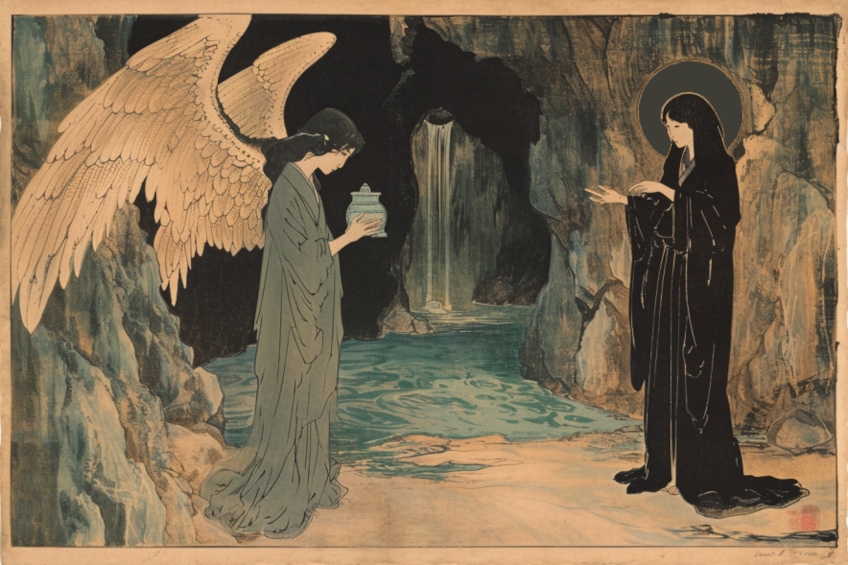 Iris collecting water from Styx for the Olympian gods to swear their oaths; artist’s impression
Iris collecting water from Styx for the Olympian gods to swear their oaths; artist’s impression
The name Styx is connected to the verb ‘stugeô’ meaning “to hate” or “abhor”, it’s also translated by sources to mean “shuddering”, and she was certainly a figure of intimidation to both gods and men.
Family Relations of Styx
Styx was an older goddess and considered the eldest of the 3000 Oceanid daughters of the Titans Oceanus, the mighty river that encircled the world, and his sister-wife the Titaness Tethys according to Hesiod’s Theogony (8th century BCE).
Hyginus, the Roman mythographer, suggests an alternative parentage in the goddess of night Nyx, and the god of darkness Erebus.
Styx is believed to be the wife of the Titan Pallas, and she bore him four children Nike, Bia, Zelus, and Kratos. She is also suggested to have borne to Perias the monstrous Echidna, supposedly by Epimenudes of Crete.
Styx’s Significance in Greek Mythology
Titans usually fill a genealogical role while adding to cosmogony or filling a geographical role. What is Styx the goddess of can be narrowed down to three primary roles. The river Styx Greek mythology references fulfills several roles as a goddess of oaths, a magical river in the underworld, and a poisonous real-life river.
The Dread Witness
Having been the very first to side with Zeus during the Titanomachy, and bringing her children to fight by his side as well, Zeus honored her highly and decreed that all oaths would be sworn upon her. This added oaths to be considered as the answer to what Styx is the goddess of. The goddess Styx became very important in myth as mortals swore by the gods so the gods would swear their oaths on the river Styx.
This is done numerous times throughout the Iliad, Odyssey, and Homeric Hymns, and was considered the greatest and most feared oath one of the deathless gods could swear.
This act of binding was used as a way of establishing trust, discerning truth, and holding a god to their words. The “dread” river Styx was thus an integral part in various myths and stories. Deceived by a jealous Hera, Zeus swears by Styx to Semele that he will grant whatever she asks of him. To his horror, the girl requests to see him in all his divine splendor, and is incinerated by his thunderbolts.
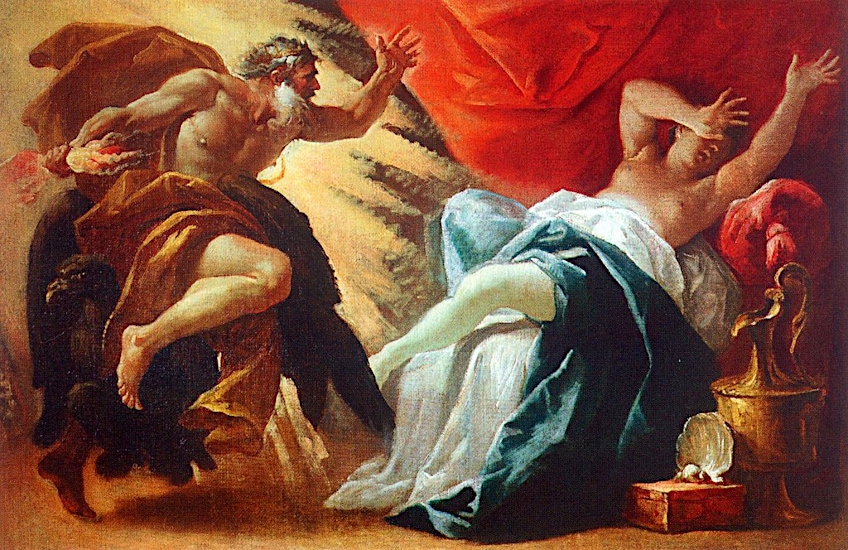 Jupiter (Zeus) and Semele by Odoardo Perini (17th-18th Century); Odoardo Perini, Public domain, via Wikimedia Commons
Jupiter (Zeus) and Semele by Odoardo Perini (17th-18th Century); Odoardo Perini, Public domain, via Wikimedia Commons
The exact punishment for a god forswearing their oath is described by Hesiod as including a year of lifeless and senseless sleep, without breath or ambrosia, and nectar and unable to move or speak. Following this they were exiled from the other gods and their assemblies and feasts for nine years after. Only after this could they then return to the courts.
The Great River of Hades
Styx was a goddess of dread power. She was like many rivers a branch of her father Oceanus, the great river encircling the world and source of all freshwater sources. Styx, however, was said by Hesiod to have been allocated a full tenth of her father’s great waters.
She was said to live in a cave at the gates of the underworld, and the Iliad (8th century BCE) names her as a “sheer-falling” boundary of Hades.
In the Aeneid (19 BCE) she encircles the underworld seven or nine times over and Charon ferries the dead across her waters, however, more traditionally it is the waterway Acheron that separates the dead and living worlds instead.
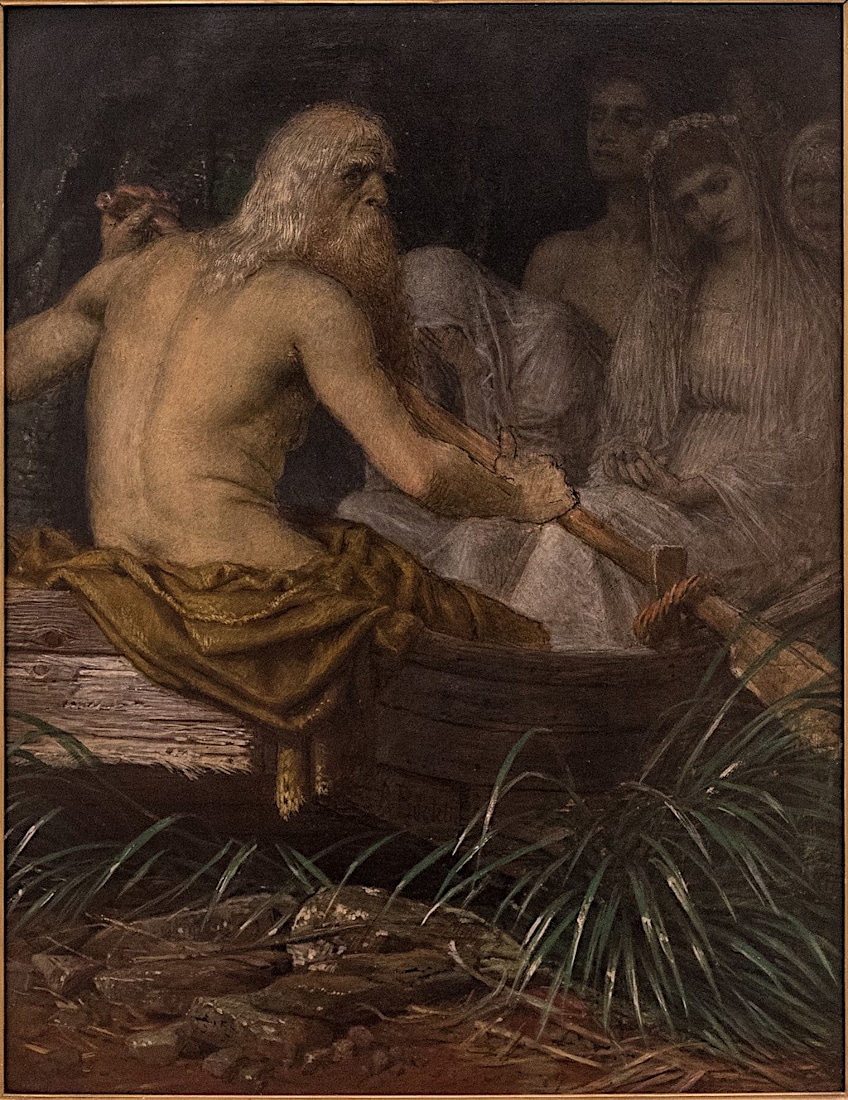 Charon by Arnold Böcklin (1876); Museum Georg Schäfer, Public domain, via Wikimedia Commons
Charon by Arnold Böcklin (1876); Museum Georg Schäfer, Public domain, via Wikimedia Commons
The story of Achilles, as written by the Roman Statius in the Achilleid (1st century CE), has Nereid Thetis dip her son Achilles in Styx’ waters in order to make him immortal. He was blessed with invulnerability everywhere except for the left heel where she held the infant as she dipped him, and it became his only spot of weakness. He was killed by Paris with the assistance of Apollo in the Trojan War when his heel was struck by an arrow.
This story is the origin of the phrase “Achilles Heel” which is used to refer to fatal flaws or catastrophic weak points.
Styx as a River in Arcadia
Over the centuries, the mythological river Styx has been thought to be several waterways in our real world, such as the Thessalian river Titaressus. Most commonly it is identified as a small stream and waterfall near Nonacris in ancient Arcadia described by Herodotus that King Cleomenes of Sparta would make men take oaths upon.
Several ancient writings report Demeter as being involved with Styx in Arcadia and her anger at the loss of her daughter Persephone being responsible for its black color.
The black Arcadian river was described by Pliny and many other writers as poisonous, able to kill immediately upon ingestion and dissolving through any material except the hoof of a mule or horse, so cold and toxic was its waters. Ancient rumors suspected that the poisonous water of Styx was to blame for the death of Alexander the Great. The danger of the river certainly supports Styx’s reputation as a river of death and hatred.
 The Death of Alexander the Great from the Great Mongol Shahnameh by an anonymous artist (c. 1330); Freer Gallery of Art, CC BY-SA 4.0, via Wikimedia Commons
The Death of Alexander the Great from the Great Mongol Shahnameh by an anonymous artist (c. 1330); Freer Gallery of Art, CC BY-SA 4.0, via Wikimedia Commons
Other Myths
Styx was named as one of Persephone’s “frolicking” companions in the Homeric Hymn 2 to Demeter (7th– 6th BCE), adding to her connections with Demeter. Retrieving water from the dragon-guarded river Styx was one of Psyche’s impossible tasks set by Venus in Apuleius’ Metamorphoses (2nd century ACE).
The Attributes of Styx
We have very few accounts describing Styx or her actions directly in literature, and her presence is mostly that of the weight of her implied threat. The river goddess’ most common descriptor is dread, she is known as the “dread river” of oaths and with her cold “dread” waters. She is also described as “stygian”, a generally unpleasant descriptor meaning gloomy or forbidding, and her very name is taken to mean “shuddering”.
Some sources claim she is the river of hatred, and that she was the first to side with Zeus against the Titans, adding a sense of dedication and shrewdness to her fearsome reputation.
 The children of Styx personify such martial notions as victory, strength, force, and glory; artist’s impression
The children of Styx personify such martial notions as victory, strength, force, and glory; artist’s impression
It is no surprise she is presented this way when one combines her placement in the underworld, her age and immense size compared to her siblings, and her being powerful enough to grant invulnerability and punish the oath-breaking gods. The children Styx bore are powerful in their own right, being the embodiments of concepts like Emulation, Victory, Strength, and Force. These chthonic connections and the gravitas of her implied power lend her status as a goddess to be feared. Foreboding as she is, however, she serves her purpose as the enforcer of godly oaths with diligence.
The Legacy of the Greek Goddess Styx
The Greek goddess Styx often serves as a kind of boogeyman who knows when you break oaths, however, for her many mentions in myth, she is curiously without any surviving myth or cult. There may have been localized worship, and Herodotus reports a ‘river Styx a spartan King would have people swear oaths upon in ancient Arcadia, however, details of her influence on Greek society and worship are sparse.
It’s unknown if there ever was a true symbol of Styx associated with her. The river Styx itself can be considered a symbol of Styx as she is its personification.
 Styx as personification of the underworld river that bears her name; artist’s impression
Styx as personification of the underworld river that bears her name; artist’s impression
Styx was associated with several other chthonic goddesses who share attributes with her, like Demeter Erinys, the earth goddess’ wrathful persona, the Eumenides who protects oaths, and the mysterious and feared goddess of night Nyx, who has been suggested as Styx’s mother.
Styx’s Modern Influence
Styx features in popular representations of Greek myth such as Rick Riordan’s fictional novel series Percy Jackson: The Heroes of Olympus series. Dante’s Inferno (14th century ACE) has become a popular representation of the Christian underworld and has influenced much of art and literature. In it the Roman poet Virgil and writer Dante eventually cross the ‘river’ Styx in the 5th Circle of Hell where Styx is depicted as foul marshland where sinners are punished.
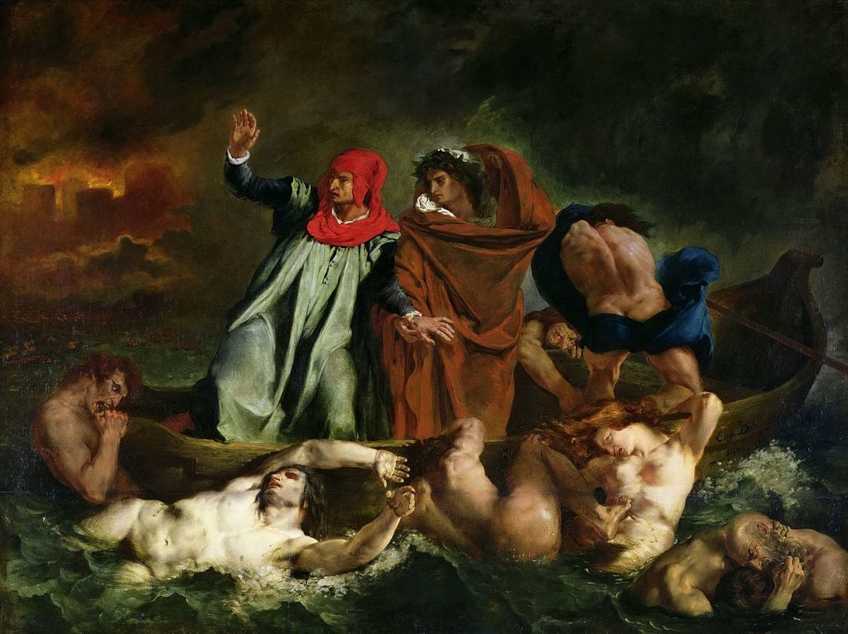 Dante and Virgil in Hell or The Barque of Dante by Eugène Delacroix (1822); Eugène Delacroix, Public domain, via Wikimedia Commons
Dante and Virgil in Hell or The Barque of Dante by Eugène Delacroix (1822); Eugène Delacroix, Public domain, via Wikimedia Commons
Today the goddess Styx lends her name to a moon that orbits Pluto, itself named for the Roman equivalent of the god of the underworld Hades.
Her daughter Nike’s name has been used for one of the most famous sportswear brands in the world to date.
The Lessons of the Greek Goddess Styx
Styx enforced the importance of sticking to your word, even if you were the king of the deathless gods. Our promises only have worth if we keep them, and the consequences can be devastating if you break them. In both a practical and personal sense, promises and oaths are important ties of trust with others. Hesiod’s description of the horrifying senseless sleep and exile from communal assemblies can be easily adapted to our own dealings in life. Being unreliable or breaking your promises can destroy people’s trust and regard for you, isolating you from others and causing suffering for both you and them. Rebuilding trust can take a long while, and can be an uphill battle.
Myths involving Styx and the penalties for breaking oaths also provide a lesson in cautious forethought and planning prior to making commitments.
Oaths made on Styx were the most binding agreement possible, and had to be followed through even if consequences you were not aware of come up. Zeus’ oath meant he had to follow through with Semele’s request even though it would result in her demise. Be careful what you agree to and be thorough in your assessments and work because even if you are not swearing on the river Styx, Achilles is a lesson that it only takes one weak point to cause irreparable damage.
 Fragment of a Roman mosaic showing Thetis submerging Achilles in the waters of the River Styx to make him invulnerable; Dosseman, CC BY-SA 4.0, via Wikimedia Commons
Fragment of a Roman mosaic showing Thetis submerging Achilles in the waters of the River Styx to make him invulnerable; Dosseman, CC BY-SA 4.0, via Wikimedia Commons
Your decisions today have a subtle but serious influence further down the line and should thus be given due diligence and care. On the flip side, Styx can also be a symbol of trust and fearless assurance of your trustworthiness and faith, and the dark hope that those who betray you will be punished for it.
This ancient river goddess is arguably one of the most foreboding figures of Greek mythology. With her looming specter to enforce oaths, many deals have been stuck and enforced throughout the ages, stretching the shadow of her influence far beyond the reaches of her own actions. The Greek goddess Styx embodies the importance of sticking to one’s commitments and thinking them through thoroughly before making them. Her cold, dark, and poisonous waters can be a paradoxical comfort, an expression of the death of your faith and commitment, or a punishment for those who betray both. Known as a delightfully gloomy and dreaded goddess, we hope you’ve enjoyed Styx’s mystique and subtle influence as much as we have.
Frequently Asked Questions
What Is Styx the Goddess Of?
Styx was the eldest Oceanid and a goddess of the underworld river of the same name. Some sources hold her as the river of hatred. She was also the river the gods would swear their oaths upon, and was thus also said to be the goddess of oaths.
What Role Did the Greek Goddess Styx Play in Myth?
The Greek goddess Styx was Zeus’ first ally in the Titanomachy and as a reward, she became the river the gods swore their oaths upon which came to be considered the most ironclad of promises. She was also the river that gave Achilles his invincibility, acted as a boundary of Hades, and in one myth was the river that Charon ferried souls across instead of the traditional Acheron.

I am deeply passionate about history and am constantly fascinated by the rich and complex stories of the past. As the editor-in-chief of learning-history.com, I have the opportunity to share this passion with a wide audience through the creation and distribution of engaging and informative content about historical events, persons, and cultures. Whether it’s through writing articles and blog posts or creating videos or podcasts, I strive to bring the past to life in a way that is both accurate and enjoyable. My expertise in history, combined with my strong writing and communication skills, allows me to effectively communicate complex historical concepts and make them accessible and interesting to a wide range of readers. I am truly grateful for the opportunity to share my love of history with others through my work on learning-history.com.


